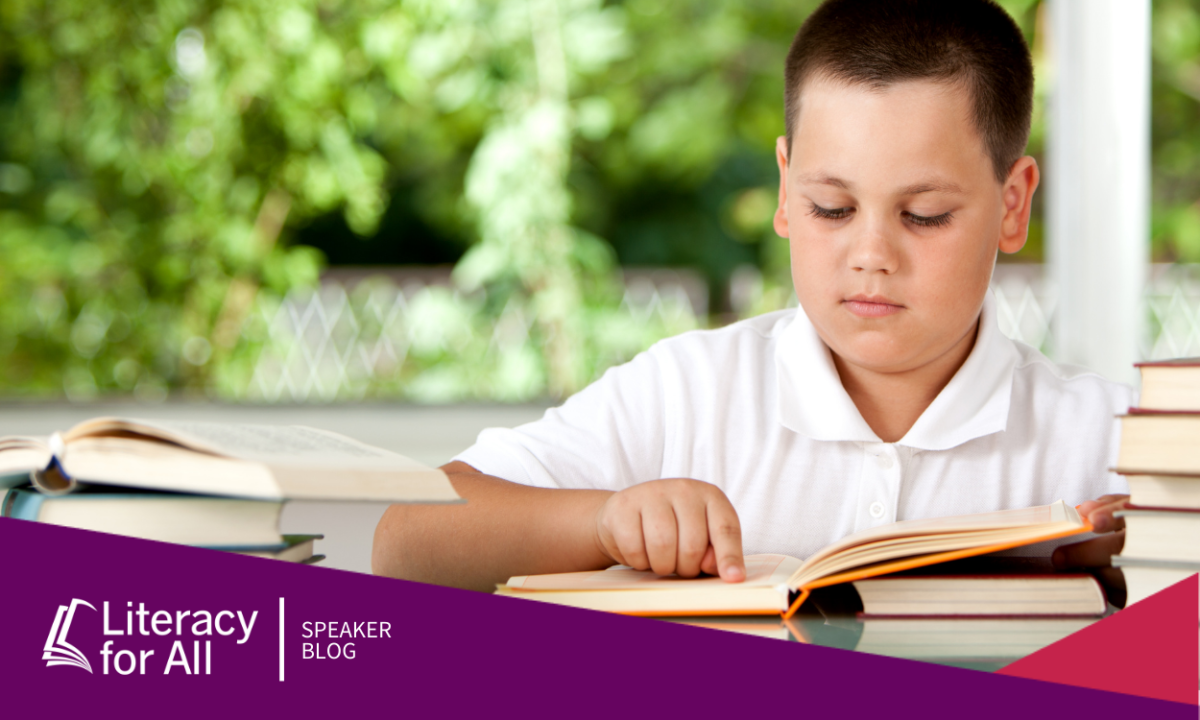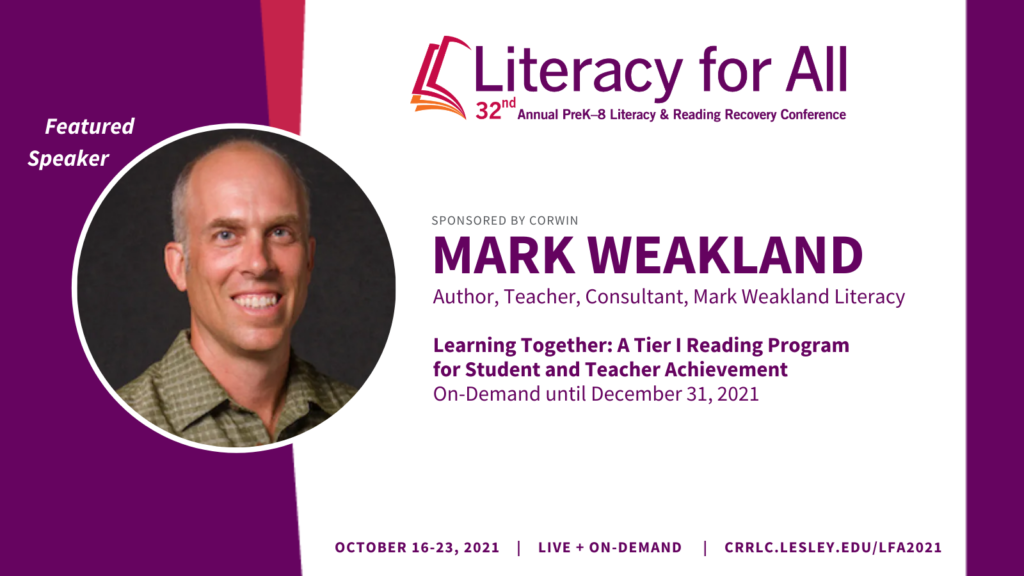Throughout my educational career – from special education teacher to reading interventionist to classroom co-teacher – I loved the point in the year when a struggling reader “took off.” Seemingly out of the blue, a student would suddenly become a much more fluent reader. When a student entered this stage of their reading development, their rate and accuracy increased dramatically and they were able to confidently and quickly traverse whole paragraphs, even when some sentences were difficult.
For decades reading research has shown us that reading fluency – the ability to read accurately, at an appropriate rate, and with proper expression and phrasing – is essential to reading comprehension (LaBerge & Samuels, 1974; Stevens, Walker, & Vaughn, 2017). One especially effective and efficient practice that builds students’ reading fluency is guided repeated reading. The activity provides less skilled readers with the opportunity to hear a model of fluent reading and then practice the same passage in a way that minimizes errors. Additionally, reading aloud with others (often with the teacher) builds confidence, lessens the stress of reading independently and supports any student who feels shy or nervous about reading out loud.
Capitalized Repeated Reading
Repeated Reading is the specific (and thus capitalized) routine pioneered by researcher Jay Samuels. It has been shown to be effective at improving the oral reading fluency of elementary students, including those with learning disabilities (Kim, Bryant, Bryant, & Park, 2017; Stevens et al., 2017; Lee & Yoon, 2017).
The routine shares these key ingredients with other varieties of repeated reading (such as echo reading, choral reading and Radio Reading):
- Student reading is done orally (as opposed to silently) so the teacher can monitor word pronunciations and note errors.
- The teacher gives support, first when she models the passage and then when the students read along with others.
- The process provides feedback, important because feedback helps readers form the exact pronunciation and spelling of every word processed by and stored within the brain’s reading circuitry (Shaywitz, 2020).
Through its very nature, Samuel’s routine gives students lots of reading practice. It goes, however, above and beyond garden varieties of repeated reading. According to Timothy Shanahan, “Repeated Reading is a particular method … to develop decoding automaticity with struggling readers. In this approach, students are asked to read aloud short text passages (50-200 words) until they reach a criterion level of success – particular speed and accuracy goals” (Shanahan, 2020). Said another way, the routine uses goal setting, instant error correction, and peer mediation to boost all components of reading fluency.
Repeated reading of all types typically leads to improved reading performance, especially for low performing readers (Zawoyski, et. al., 2014), with the biggest payoffs being more accurate word reading, improved oral reading fluency, and more reading comprehension (Shanahan, 2020). Still, some schools and teachers don’t make use of this powerful practice. Here’s what dyslexia researcher Sally Shaywitz has to say: “…the proven effectiveness of guided repeated oral reading to increase fluency is too often ignored. That is unacceptable. In fact, the evidence is so strong that I urge adoption of these programs as an integral part of every school reading curriculum throughout primary school” (Shaywitz, p. 233).
Fortunately, it doesn’t take much time and effort to understand and then adopt the practice in your reading block. If you would like to absorb Samuel’s Repeated Reading routine well enough to use it with your readers who struggle, here are three resources to explore:
- IRRC blog: Repeated Reading with Goal Setting for Reading Fluency: Focusing on Reading Quality Rather Than Reading Speed
- Reading Rockets Blogs About Reading: Everything You Wanted to Know About Repeated Reading
- Samuel, S.J. (1997). The method of repeated readings. The Reading Teacher. 50 (5). 1997
A final note
The work of S. Jay Samuels has had a profound impact on the field of reading instruction. Dr. Samuels passed away last year in December. Whether they know it or not, teachers who engage in quality reading instruction have been influenced by Dr. Samuels and countless children have become better readers because of his insights. If you’d like to read about S. Jay Samuel’s life and reflect on his accomplishments, follow this link and read the “in memorium.”
—
Citations and sources:
IRRC blog: Repeated Reading with Goal Setting for Reading Fluency: Focusing on Reading Quality Rather Than Reading Speed
Kim, M. K., Bryant, D. P., Bryant, B. R., & Park, Y. (2017). A synthesis of interventions for improving oral reading fluency of elementary students with learning disabilities. Preventing School Failure: Alternative Education for Children and Youth, 61, 116–125. doi:10.1080/1045988X.2016.1212321
LaBerge, D., & Samuels, S. J. (1974). Towards a theory of automatic information processing in reading. Cognitive Psychology, 6, 293-323. doi:10.1016/0010-0285
Lee, J., & Yoon, S. Y. (2017). The effects of repeated reading on reading fluency for students with reading disabilities. Journal of Learning Disabilities, 50, 213-224. doi: 10.1177/0022219415605194
Reading Rockets Blogs About Reading: Everything You Wanted to Know About Repeated Reading
Shawitz, S. & Shaywitz, J. (2020). Overcoming Dyslexia: Second Edition, Completely Revised and Updated. Knopf.
Stevens, E. A., Walker, M. A., & Vaughn, S. (2017). The effects of reading fluency interventions on the reading fluency and reading comprehension performance of elementary students with learning disabilities: A synthesis of the research from 2001 to 2014. Journal of Learning Disabilities, 50, 576-590. doi:10.1177/0022219416638028
Zawoyski, A., Ardoin, S., & Binder, K. (2014). Using Eye Tracking to Observe Differential Effects of Repeated Readings for Second-Grade Students as a Function of Achievement Level. Reading Research Quarterly. 50(2), 171–184.
About the Author – Mark Weakland
A teacher, reading specialist, writer, and musician, Mark enjoys exploring the intersections of education, literacy, science, and the arts. As a national and regional consultant and coach, Mark works with students, teachers, and administrators to create effective literacy programs, as well as authentic and extended reading and writing experiences. As an artist, Mark strives to write books, play music, and craft workshops that engage and inspire. Mark holds a master’s of education degree from the University of Pittsburgh. He was the recipient of an Owens Fellowship and studied in Japan under the auspices of the Japanese Fulbright Memorial Fund. His teaching certifications include reading specialist, special education, elementary education, and general science. For many years, Mark was a teacher, first in a learning support classroom (grades 4 and 5) and then as a Title I reading specialist (grades K to 6). In between his teaching assignments, he worked as an educational consultant, providing professional development in the areas of reading and instructional practices. In 2014 he left public education and formed his own company, Mark Weakland Literacy. It’s been an adventure ever since. Mark is sponsored by Corwin.






